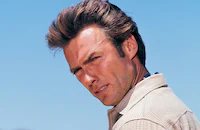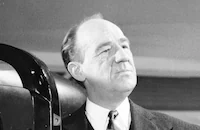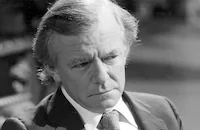Where Eagles Dare

Brief Synopsis
Cast & Crew
Brian G. Hutton
Richard Burton
Clint Eastwood
Mary Ure
Patrick Wymark
Michael Hordern
Film Details
Technical Specs

Synopsis
Under the command of British Major John Smith, an international commando unit dressed in Nazi uniforms parachutes into the Bavarian Alps with the objective of rescuing a World War II Allied officer from a German castle-fortress known as the Castle of the Eagle. After one of the commandos is found with his neck broken, Smith first rendezvouses with agent Mary Ellison and then with another agent, Heidi, who, by posing as a local barmaid, succeeds in getting Mary into the fortress by introducing her as a cousin. Following the murder of a second commando and the capture of three other men, Smith and his second-in-command, American Ranger Morris Schaffer, are forced to surrender. But they escape and gain entry into the fortress by crouching on the roof of a cable car. Once there, Smith reveals to Schaffer that the Allied officer is really an actor, and that the real purpose of the mission is to discover the identity of German spies in England. After the actor-imposter has been rescued, Smith tricks the three "captured" commandos into exposing themselves as German agents. Now that they have the vital information they were sent for, Smith, Schaffer, Mary, and the imposter must face the problem of escaping. Having wired the fortress as well as certain sites in the village to explode at intervals, they make their way to a cable car. Once aboard, they outwit the Germans, reach the village, leap off the cable car, and, with the enemy still in hot pursuit, make their way through a canal to a garage. There they commandeer a bus and drive to an airfield where a plane is arriving to take them back to England. Once they are in flight, Major Smith forces one of the mission's organizers, Colonel Turner, into confessing that he is a German agent. To prevent humiliation to Turner and his family, as well as a national scandal, Smith permits Turner to meet a more honorable death by allowing him to leap from the plane.

Director

Brian G. Hutton
Cast

Richard Burton

Clint Eastwood

Mary Ure

Patrick Wymark

Michael Hordern
Donald Houston

Peter Barkworth
William Squire

Robert Beatty
Brook Williams
Neil Mccarthy
Vincent Ball

Anton Diffring
Ferdy Mayne
Derren Nesbitt
Victor Beaumont
Ingrid Pitt
Richard Beale
Ivor Dean
Lyn Kennington
Nigel Lambert
Michael Rooney
Ernst Walder
Crew
Jonathan Bates
John Bramall
Colin Brewer
Yakima Canutt
Patrick Clayton
Penny Daniels
Jerry Gershwin
Ron Goodwin
Ben Harrison
Fred Hellenburgh
Denis Holt
Tom Howard
Arthur Ibbetson
John Jympson
Elliott Kastner
Elliott Kastner
Chris Kenny
Alfredo Lettieri
Ted Lloyd
Alistair Maclean
Richard Mcwhorter
Peter Mullins
Richard Parker
Marion Rosenberg
Tom Sachs
J. B. Smith
Alan Strachan
Arthur Taksen
H. A. R. Thomson
Anthony Waye
Paul Wilson

Photo Collections
Videos
Movie Clip



Trailer
Hosted Intro





Film Details
Technical Specs

Articles
Where Eagles Dare
Relatively unknown director Brian G. Hutton was tapped to steer the picture from script to screen. One of producer Elliot Kastner's duties was to secure permission to shoot in Schloss Hohenwerfen, a famous 11th-century castle in Austria nestled on a peak in the Alps. The 300 plus production team arrived on location in Salzburg, Austria at the beginning of January 1968. Production began amid the dangers of blizzards, subzero temperatures, unpredictable high winds, slippery roads, avalanches, and treacherous stuntwork. Once the location shooting was finished five months later, the production wrapped principle photography at the Elstree-based MGM British studios, which closed shortly thereafter due to financial reasons.
Another major player in the production of Where Eagles Dare was famed stuntman Yakima Canutt, who was hired to coordinate and direct the hair-raising action sequences. Canutt, a veteran stunt performer since the silent era, eventually retired from performing stunts and went into the very important business of designing and directing key action sequences, such as the famous chariot race in Ben-Hur (1959) and the battle scenes in Spartacus (1960). Adept at working with horses, chariots, and fight sequences staged on terra firma, Canutt signed on with the production of Where Eagles Dare in the fall of 1967 and quickly found a whole new set of challenges facing him: parachute stunts, a fight sequence on top of a moving Alpine cable car, and careening car chases on treacherous mountain roads. Canutt began pre-production in London by hiring a group of key stunt performers: Joe Powell, Eddie Powell, Peter Brace, Jimmy Thong, Jackie Cooper, Doug Robison, Terry York, Alf Joint, and Gillian Aldam. These stunt performers dominated most of the action sequences, much to the chagrin of Clint Eastwood, who initially requested to perform his own stunts. Because he was too valuable a property and the stunts in Where Eagles Dare much too dangerous, Eastwood nicknamed the production "Where Doubles Dare." Of course, even Eastwood must have thought twice about hanging off a moving cable car hundreds of feet in the air, as did his own stunt double, Eddie Powell. The actual on-location shooting that Canutt shot was then intercut with studio shots made at the MGM British studios.
In the end, the personal risks paid off well at the box office as Where Eagles Dare was a huge popular hit with audiences after the March 1969 national release. Critics responded enthusiastically as well. In a December 11, 1968 review, Variety wrote that "Where Eagles Dare is so good for its genre that one must go back to The Great Escape (1963) for a worthy comparison." Interestingly enough, Clint Eastwood, whose reputation for screen violence is well known thanks to his trilogy of spaghetti Westerns with director Sergio Leone, kills more people in this film than in any other Eastwood character in a single film to date. Meanwhile, the original impetus for the project helped boost Richard Burton's previously sagging career, though some of the critics accused him of selling out. A March 28, 1969 review in Time lamented that "it is a little melancholy to see Richard Burton reduced to playing cardboard parts like this one, but he at least manages to look as if he's having a good time." For the most part though, Where Eagles Dare was a bright spot for MGM in 1969, at a time when the studio's very future was gravely in question.
Director: Brian G. Hutton
Producer: Elliott Kastner, Denis Holt
Screenplay: Alistair MacLean
Cinematography: Arthur Ibbetson
Editor: John Jympson
Art Direction: Peter Mullins
Music: Ron Goodwin
Cast: Richard Burton (Maj. John Smith), Clint Eastwood (Lt. Morris Pimpennel Schaffer), Mary Ure (Mary Ellison), Patrick Wymark (Col. Wyatt Turner), Michael Hordern (Vice Admiral Rolland).
C-156m. Letterboxed. Closed captioning.
by Scott McGee

Where Eagles Dare
Where Eagles Dare on DVD
Relatively unknown director Brian G. Hutton was tapped to steer the picture from script to screen. One of producer Elliot Kastner's duties was to secure permission to shoot in Schloss Hohenwerfen, a famous 11th-century castle in Austria nestled on a peak in the Alps. The 300 plus production team arrived on location in Salzburg, Austria at the beginning of January 1968. Production began amid the dangers of blizzards, subzero temperatures, unpredictable high winds, slippery roads, avalanches, and treacherous stuntwork. Once the location shooting was finished five months later, the production wrapped principle photography at the Elstree-based MGM British studios, which closed shortly thereafter due to financial reasons.
Another major player in the production of Where Eagles Dare was famed stuntman Yakima Canutt, who was hired to coordinate and direct the hair-raising action sequences. Canutt, a veteran stunt performer since the silent era, eventually retired from performing stunts and went into the very important business of designing and directing key action sequences, such as the famous chariot race in Ben-Hur (1959) and the battle scenes in Spartacus (1960). Adept at working with horses, chariots, and fight sequences staged on terra firma, Canutt signed on with the production of Where Eagles Dare in the fall of 1967 and quickly found a whole new set of challenges facing him: parachute stunts, a fight sequence on top of a moving Alpine cable car, and careening car chases on treacherous mountain roads. Canutt began pre-production in London by hiring a group of key stunt performers: Joe Powell, Eddie Powell, Peter Brace, Jimmy Thong, Jackie Cooper, Doug Robison, Terry York, Alf Joint, and Gillian Aldam. These stunt performers dominated most of the action sequences, much to the chagrin of Clint Eastwood, who initially requested to perform his own stunts. Because he was too valuable a property and the stunts in Where Eagles Dare much too dangerous, Eastwood nicknamed the production "Where Doubles Dare." Of course, even Eastwood must have thought twice about hanging off a moving cable car hundreds of feet in the air, as did his own stunt double, Eddie Powell. The actual on-location shooting that Canutt shot was then intercut with studio shots made at the MGM British studios.
In the end, the personal risks paid off well at the box office as Where Eagles Dare was a huge popular hit with audiences after the March 1969 national release. Critics responded enthusiastically as well. In a December 11, 1968 review, Variety wrote that "Where Eagles Dare is so good for its genre that one must go back to The Great Escape (1963) for a worthy comparison." Interestingly enough, Clint Eastwood, whose reputation for screen violence is well known thanks to his trilogy of spaghetti Westerns with director Sergio Leone, kills more people in this film than in any other Eastwood character in a single film to date. Meanwhile, the original impetus for the project helped boost Richard Burton's previously sagging career, though some of the critics accused him of selling out. A March 28, 1969 review in Time lamented that "it is a little melancholy to see Richard Burton reduced to playing cardboard parts like this one, but he at least manages to look as if he's having a good time." For the most part though, Where Eagles Dare was a bright spot for MGM in 1969, at a time when the studio's very future was gravely in question.
The Warner Video DVD of Where Eagles Dare is a handsome transfer and is part of the company's on-going series, "The Clint Eastwood Collection." Disc extras are pretty spare but include the theatrical trailer and a featurette, "On Location: Where Eagles Dare", which has lots of unique behind-the-scenes footage of Eastwood, Burton and crew members filming high up in the Swiss Alps. The image quality of the latter is rough (lots of dirt, scratches and print imperfections) but definitely viewable. The liner notes also mention "Eastwood Film Highlights" as an extra but it's nowhere to be found unless it's hidden in the menu interface somewhere.
For more information about Where Eagles Dare, visit Warner Video. To order Where Eagles Dare, go to TCM Shopping.
by Scott McGee
Where Eagles Dare on DVD
Quotes
I nearly froze to death in that damn plane. Why couldn't you have supplied some hot water bottles or an electrically heated suit? I thought you loved me.- Mary Ellison
Can't help what you think.- Major John Smith
Security? The word's become a bloody joke!- Vice Admiral Rolland
That was quick.- Major John Smith
Fear lent him wings, as the saying goes.- Lieutenant Morris Pimpennel Schaffer
Lieutenant, in the next 15 minutes we have to create enough confusion to get out of here alive.- Major John Smith
Major, right now you got me about as confused as I ever hope to be.- Lieutenant Morris Pimpennel Schaffer
You seem to have a lot of women stashed around this country, Major.- Lieutenant Morris Pimpennel Schaffer
Trivia
The driving force behind the film was 'Burton, Richard' 's son, who wanted to see his father in a good old-fashioned adventure movie. Burton approached producer Elliott Kastner for ideas, who asked Alistair MacLean. At that time, most of MacLean's novels had either been made into films, or were in the process of being filmed. Kastner persuaded MacLean to write a new story. Six weeks later, MacLean delivered the script.
Clint Eastwood was reluctant to receive second billing to Burton, but agreed after being paid $800,000.
The "Schloss Adler" is actually the "Schloss Hohenwerfen" in Austria. At the time of filming, the castle was being used as a police training camp.
An accident during one of the action scenes left Kastner and director Brian G. Hutton badly burnt.
Despite Eastwood's reputation for violence in other films, his character kills more people in this film than any other Eastwood character.
Notes
Location scenes filmed in the Austrian Alps; released in Great Britain in 1968.

Miscellaneous Notes
Released in United States 2014
Released in United States on Video September 1987
Released in United States Winter December 1968
Released in United States 2014 (Revivals)
Released in United States on Video September 1987
Released in USA on laserdisc December 6, 1988.
Released in United States Winter December 1968














